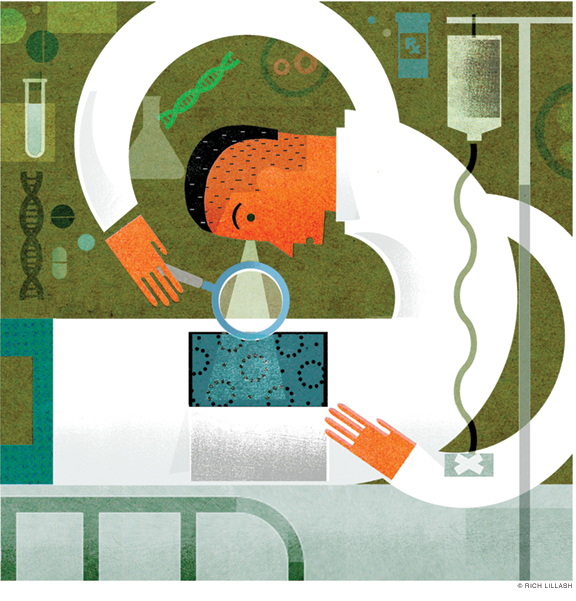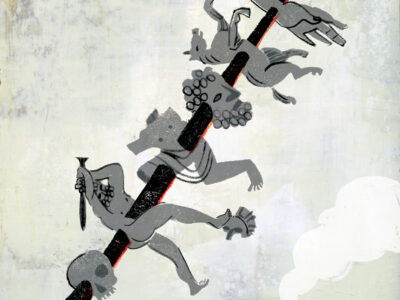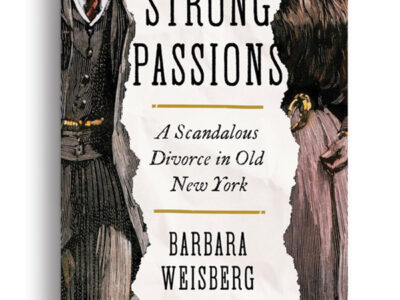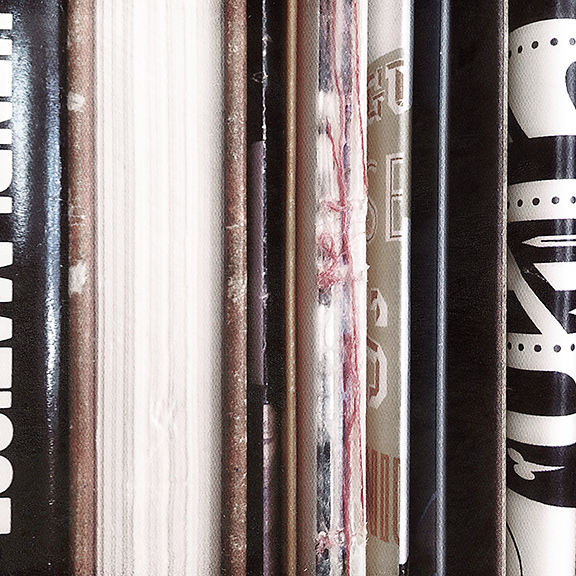
No one knew how to cure my disease.
By David Fajgenbaum
I needed answers. I may or may not have been approaching death for the fourth time. As a cocktail of seven chemotherapy drugs dripped into my arm through an IV pole, I asked Dr. van Rhee everything I had been obsessing over since my case of Castleman disease had come roaring back … again.
“What causes this to happen?”
“No one knows.”
“Which type of immune cell is responsible for initiating this?”
“No one knows.”
Why not? I wanted to ask. And why me?
I swallowed those final questions, but a hospital room is never, ever silent, even in the dead of night, or even when a conversation grinds to a halt and the participants are left to quietly pick at the implications of what’s been said, and what’s been impossible to say.
Dr. van Rhee was not saying “I don’t know” to my queries about my illness. He might have said, “I’m not sure, let me look that up—” and swiveled over to his computer to plug in the symptoms and dial up answers. But he didn’t say that. He said, “No one knows.”
“Are there any other drugs in development or clinical trials?”
Dr. van Rhee was unfailingly calm and caring when he responded to my most important question. “No, not at the moment.”
“Are there any planned?”
“Not that I’m aware of.”
I was talking to the undisputed worldwide expert on Castleman disease, and he didn’t know what initiated the disease or what caused it. Or how to prevent relapses in patients for whom the only experimental treatment in development didn’t work. That meant that no one knew. There were no more appeals. There was no higher bench. He was not flattering himself by speaking on behalf of the world’s knowledge of my condition. He was that knowledge. He didn’t just have authority; he was the authority.
As a medical student, I could select the correct answer to each of these questions for what seemed like every disease, but not this one.
“I know elevated interleukin 6 is supposed to be the problem, but blocking it hasn’t worked twice now and my interleukin 6 tests were normal during my presentation and relapses,” I said. “Is it possible that interleukin 6 isn’t the problem for all cases?”
“It’s possible.”
That was it. It was possible. Anything was possible.
I knew what he meant. I knew the language that doctors use: the careful truth telling, the hedging, the open-endedness. I’d spoken that language before. Now that it was directed at me, it didn’t feel nearly as careful, or open-ended, as I’d once assumed. I’d been consigned to the plane of possibility. Anything was possible, because no one knew. I was on my own.
A proper patient might have taken Dr. van Rhee’s pronouncements with humility and acceptance, but no one knows didn’t cut it for me. There are things we can change and things we cannot change. We need either the grace to accept them, the ignorance to not know the difference, or prayers to find another expert who has the answers. I am not graceful. I was no longer ignorant of the realities of idiopathic multicentric Castleman disease. And I was getting tired of praying.
A whole mental structure built on faith and expectation—or hubris—collapsed for me that day. When Dr. van Rhee entered that room to discuss my disease rationally—doctor to emerging doctor—I had believed there had been a vast, unseen, but highly coordinated system of scientists, companies, and physicians working diligently to cure my disease. Every disease, actually. Of course there was. Right?
Like Santa and his elves working to grant wishes to every good boy and girl in the world, I imagined that for every problem in the world, a highly qualified team worked diligently, perhaps in a workshop, and it operated out of sight, out of mind, right up until the moment that it solved the problem. Google reinforces this belief. For every question you can think of, Google provides an answer—and often data to back it up—with a speed and precision that inspire confidence, if not always comfort. Steady news reports about medical breakthroughs feed this optimistic illusion: a cure is near; discoveries will happen whether or not you contribute time, talent, or dollars toward them. So I had waited on the sidelines, believing others were on the case. But that illusion was no longer possible to sustain. Not when Santa Claus himself was looking me in the eyes and telling me nothing would materialize, gift-wrapped, to cure me.
Nausea overwhelmed me, partly because of the chemotherapy and partly because of the realization that I was completely alone. I was terrified. This was the fourth time in the last two years that I was approaching the precipice of death. This time, I knew that I would die, because the only drug in development for my disease had failed to work. The harsh reality was that the medical community didn’t understand the most basic aspects of my illness, and the world’s expert in it had run out of ideas and options for me.
Despite the fact that my immune system was consuming all of my energy as it attacked my organs, despite the accumulated toxins that clouded my thinking, I had the most clear and important thought of my young life: I could no longer just hope that my treatment would work. I could no longer hope someone else, somewhere, would make a breakthroughs that could save my life. No: I had to get off the sidelines and act. If I didn’t start fighting back to cure this disease, I would soon die. I would never get to marry Caitlin or have a family with her. I had to start now.
My body was dying. I was spent. But at least I wasn’t on the sidelines anymore. Now I was in the game, and I knew what I had to do. I would simply have to increase the world’s medical knowledge about Castleman disease.
My sisters, Caitlin, and Dad were seated around the bed and had listened to Dr. van Rhee’s every word. They stared down at the floor between long blinks and deep breaths.
I interrupted the silence. “If I survive this, I’m going to dedicate the rest of my life—however long that may be—to answering these unknowns and curing this disease.”
I heard myself like Winston Churchill vowing to fight on the beaches, but my pledge was less than stirring to Caitlin and my family. The words landed with a polite thud. They each gave half a smile—a kind of smile that I had seen before. The one where they purse their lips and close their eyes. They weren’t interested in heroics.
Yet this was the moment when I realized I was finally done with passive hope. Years before, I had found a quote in my mother’s purse by Pope John Paul II, articulating a call to be “invincible in hope.” I’d interpreted it as a conviction that invincibility came simply from having faith that your hopes and dreams would come true. You just needed to trust and wait. Taking action, in my reading, was almost in opposition to being invincible in hope. But much later I found the remainder of the Pope’s speech. He went on to say, “Happiness is achieved through sacrifice. Do not look outside for what is to be found inside. Do not expect from others what you yourselves can and are called to be or to do.”
Now I knew what I had been called to do. I asked the nurse for a dose of Zofran for my nausea. I asked my sister Gena if she could get a copy of my bloodwork. She wiped away tears and sprang into action, eager to do something, anything that could help her little brother. I needed my test results so I could start studying my disease—and also so I could estimate how much time I likely had before kidney or liver failure left me incapacitated, or dead.
Then I squared up to this beast of a disease. With three more days of continuous cytotoxic chemotherapy and then 17 days of interspersed chemo ahead of me, my hair would soon start falling out in clumps, the way it had before. But I didn’t want to wait for it to fall out again, and I didn’t want this disease or the therapy to be the cause. This time I would act. I asked my dad to buy an electric razor, and he shaved all my hair off, save a small strip of short hair down the middle. I had always wanted a Mohawk.
David Fajgenbaum M’13 WG’15 is an assistant professor of translational medicine and genetics at Penn. From Chasing My Cure by David Fajgenbaum, copyright © 2019 by David Fajgenbaum. Used by permission of Ballantine Books, an imprint of Random House, a division of Penguin Random House LLC. All rights reserved. No part of this excerpt may be reproduced or reprinted without permission in writing from the publisher.




